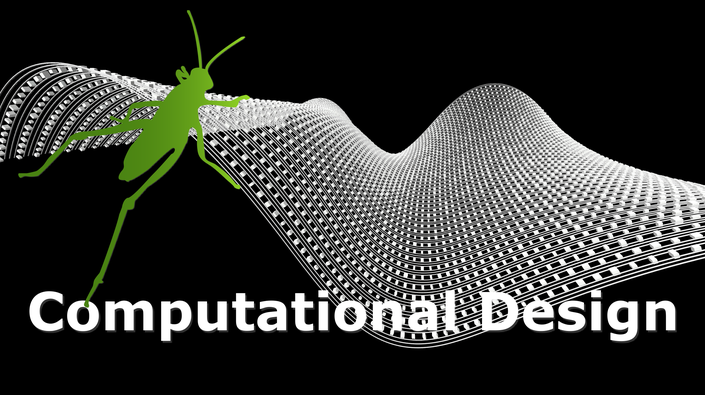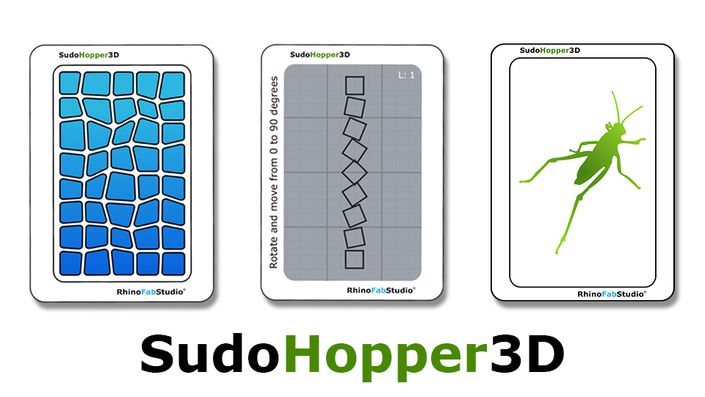


This is the outline of the course [+/- 7 Hours]
Note: Subtitles in English, French, Italian, and German
- 3.1 There are three main methods to panel
- 3.1 ... (a) Connect grid points to create edges, surfaces, or mesh faces of the intended pattern (Panel Connections) (3:51)
- 3.1 ... (b) Morph a unit module and distribute it over unit paneling grid (Morph 2D) (1:25)
- 3.1 ... (c) Morph a unit module in a variable way along the grid, depending on design constraints (Morph 2D Mean) (5:03)
- 3.2 The world is not flat after all... (Surface Domain Number) (3:46)
- 3.3 A simple quiz
- 5.1 The ptDivideDis and ptDivideParam (4:43)
- 5.2 The ptDivideLen component calculates divide points on a curve or list of curves by specified length on curve with an option to round the distance up or down (3:16)
- 5.3 ptDivideNum component calculates divide points on a curve (0:56)
- 5.4 The ptDivideDisRef component divides curves by distance with reference point. (2:16)
- 6.1 The ptPlanar component creates parallel planar grids. (1:09)
- 6.2 The ptExtrudePlanar component creates extrude grids. (2:36)
- 6.3 The ptExtrudePolar component creates polar 3D grids. (4:33)
- 6.4 The ptUVCrvs component generates a grid from intersecting two sets of curves. (2:18)
- 6.5 The ptSrfDomNum component generates a grid using a surface and follows the surface domain direction. (2:34)
- 6.6 The ptSrfParam component give you control over how to divide the surface domain using parameter space. (6:43)
- 6.7 The ptSrfDomLen Create grid from surface domain by length on surface (3:39)
- 6.8 The ptSrfDis component attempts to divide a surface by equal distances. (3:46)
- 6.9 The ptSrfDomChord calculates distance between points is set to the 3D direct distance. (3:12)
- 6.10 The ptComposeNum component helps create grids from scratch. (3:44)
- 6.11 ptCompose, Its takes a list of points and two integer lists to define the (i.j) location of each point in the grid and outputs the grid. (7:03)
- 6.12 ptPolar2D component creates polar planar grids. (4:12)
- 6.13 Very hard quiz and homework!
- 7.1 Point Attractors ( ptPointsAtts ) (3:24)
- 7.2 Random Attractors ( ptRanAtts ) (1:30)
- 7.3 The ( ptWeight ) component allows the user to feed a weight field or grid and control attraction directly. (2:26)
- 7.4 Curve Attractors ( ptCrvAtts ) (2:37)
- 7.5 Shuffles Grid of points on a Surface Mean Curvature ( ptMean ) (4:47)
- 7.6 Exercise: Let us use a Bitmap to generate Weights and use that to shuffle points ( ptWeight ) (3:10)
- 7.7 Homework and time to use your imagination!
- 9.1 The ptCenter component extracts the center grid of another input grid. (3:16)
- 9.2 The ptToDiamond component converts rectangular grids to diamond grids. (3:05)
- 9.3 The ptCoordinate Calculates grid (or cells) coordinates. (2:36)
- 9.4 The ptCoordinate3D calculates the box cell coordinates (4:07)
- 9.5 The ptCol and ptRow components help extract columns or rows from the grid. (4:19)
- 9.6 The ptIndices takes as an input a grid of points and output 2 grids of integers (5:01)
- 9.7 The ptSubGrid helps extract part of the grid. (3:50)
- 9.8 The ptGridSrf creates a NURBS surface out of a given grid. (2:19)
- 9.9 The ptWrap copy in place rows or columns and append to the end of the grid. (4:43)
- 9.9 ... (a) Exercice: Using the ptPolar2D and ptWrap (4:36)
- 9.10 The ptItem extracts a point or list of points in a grid given their “i” and “j” indices. (2:49)
- 9.11 The ptDir helps reverse the grid row and column directions. (3:22)
- 9.12 The ptDense changes grid density and either increase or decrease it. (4:21)
- 9.13 The ptTrim trims a grid using base brep. (4:02)
- 10.1 The ptCell generates list of wires, borders and meshes of the paneling cells using a grid of points. (4:00)
- 10.2 The ptBorders and ptFaces create a structure of borders(poly-curves) or faces (3:37)
- 10.3 The ptFlatFaces creates a structure of best-fit planar faces. (3:04)
- 10.4 The ptMorph2D component distributes 2D modules over a given paneling grid. (3:41)
- 10.4 ... (a) Exercise: With the ptMorph2D, ptSubGrid, ptRandom and Weight Attraction components. (6:31)
- 10.4 ... (b) Exercise: Working with history and ptMorp2D (10:32)
- 10.5 The ptMorph2DList is a variable distribution of a list of modules using attractors. (3:53)
- 10.6 The ptMorph2DMap component maps each module in a list, to one grid cell. (6:48)
- 10.7 The ptMorph2DMean copy in place rows or columns and append to the end of the grid. (4:35)
- 10.8 The ptMPanel helps generate very fast and efficient pattern coverage through connecting grid points. (4:12)
- 10.9 Homework: What is the Pattern ?
- 10.10 A very nice quiz!
- 11.1 The pt3DCell generates list of wires, cell corners and meshes of the 3D cell. (4:26)
- 11.2 The ptMorph3D morphs 3D modules to 3D cells enclosed by two bounding grids. (4:27)
- 11.2 ...(a) Exercise: ptMorph3D morphing a 3D Tile with a Bounding Object (5:12)
- 11.3 The ptMorph3DList morphs 3D list of modules to 3D cells enclosed by two bounding grids. (7:49)
- 11.4 The ptMorph3DMap maps each module in a list to one 3D grid cell. (6:50)
- 11.5 The ptmPanel3D creates 3D paneling using modules defined by connecting grid points. (5:53)
- 11.6 Quiz about the ptmPanel3D
- 12.1 A parametric ring with SubD Multipipes and a curve magnet (14:38)
- 12.2 Tween between curves and the ptUVcrvs PT component (7:13)
- 12.3 A parametric 3D Tower with a ptMorph3DList and ptMorph3DMap (14:53)
- 12.4 Few tips that you can use with PT for Rhino, SubD and PT for GH (9:54)
- 12.5 Using the param Value List and the ptMorph2Dmean component (10:58)
- 12.6 Let make a nice 3D weave with PT and the Pipe component (12:04)
- 12.7 Panel grid with SubD Multi Pipe (8:19)
- 12.8 Let us use the ptComposeNum component to get a grid (10:02)
- 12.9 Draw the points in Rhino and use them as your interface to deform the PT Grid (8:05)
- 12.10 Deform the PT Grid with a point magnet in the Z axis (6:05)
- 12.11 The end of this course, please let us know what you will do with Paneling tool!

Earn your own certificate!
If you cover more than 90% of the material of this course, you will be able to download your personalized certificate.
*Our online courses do not qualify for proof of academic status for a Rhino educational license as we are not an accredited school offering a degree program.*

Learn about your teacher
Andrés is a software trainer and developer since the 1980s. He has developed applications for diverse design markets as well as training materials for different CAD and Design software products, including AEC Metric PRO, Mepal Draw, and the Integrator (BIM) for Autocad (2010-2016). Also, he has created training materials for the Rhino community at www.rhino3d.tv. Andrés has also written numerous multimedia instructional materials for Rhino, Flamingo, Grasshopper, RhinoCAM, SudoHopper3D, etc.



